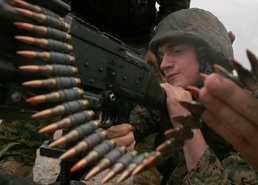
By Lance Cpl. Bryan A. Peterson
III Marine Expeditionary Force PAO
CAMP HANSEN, OKINAWA, Japan -- Nearly 160 Marines and sailors with Marine Air Support Squadron 2, known to its Marines as 'The Deuce,' wrapped up five days of a rainy field training exercise in the Central Training Area Dec. 1.
The squadron, whose primary mission is to provide direct air support capabilities for control and coordination of aircraft, focused on overall combat readiness during the annual battle skills training at Landing Zone Buzzard.
"We can get deployed at any time and we need to be ready," said Sgt. Maj. Jose Henao, the squadron sergeant major. "If we get deployed as a squadron, we need to be able to conduct security patrols to ensure the enemy does not infiltrate our perimeter and that's what part of this training is all about."
At the start of the training, the squadron was divided into 13 teams, and each was given operations orders. The teams then went through 14 stations for small unit leadership evaluation.
The stations included training on patrolling; tactical measures; weapons; simulated nuclear, biological and chemical warfare attacks; first aid; land navigation and communications. The Marines were given 30 minutes at each station leaving no time to second guess themselves.
Sgt. Vaughn Burkamper, an air support operations operator, said he has led Marines on deployments, but working out in the field was a completely different environment.
"Being a (noncommissioned officer) in your job that you do everyday from nine to five doesn't mean you can go out in the field knowing it all," he said. "We don't do this on a regular basis and coming out here was just a great experience that helped us all."
One day of training was devoted to firing the M-240G medium machine gun and the M-1014 tactical 12-gauge joint service shotgun. The unit expanded more than 3,000 rounds of 7.62 mm ammunition and 400 shotgun shells, Henao said.
The culmination of the training evolution began with early-morning patrols through quiet jungles with simulation rounds in tow. Marines equipped with protective masks, helmets and flak jackets quickly found themselves in the midst of heated firefights.
"We knew we were going to get attacked," said Lance Cpl. Jonathan Schroeder, an air support operations operator. "It seemed as soon as we entered a path in the jungle, we got lit up."
Once attacked, Schroeder's company set up in a defensive perimeter. The officers and NCOs then gathered another platoon and surprised their attackers by flanking their vulnerable position and inflicting 19 would-be enemy casualties.
Lt. Col. John C. Reimer, the squadron commanding officer, said he hopes the exercise won't be the unit's last of the year. Occasions in which all Marines from the squadron are available at the same time are rare.
"We would like to conduct this training quarterly, but with deployments, once a year is pretty much the only time we can spare," Reimer said.
With the training finished the Marines headed back to their command post, where the squadron's senior leaders treated their Marines to a barbecue and Reimer praised his Marines and sailors.
"Back in World War II, Marines climbed through the same mud that you ladies and gentlemen did this week, and you all should be proud," he said. "It's a good day to be a Marine and sailor."